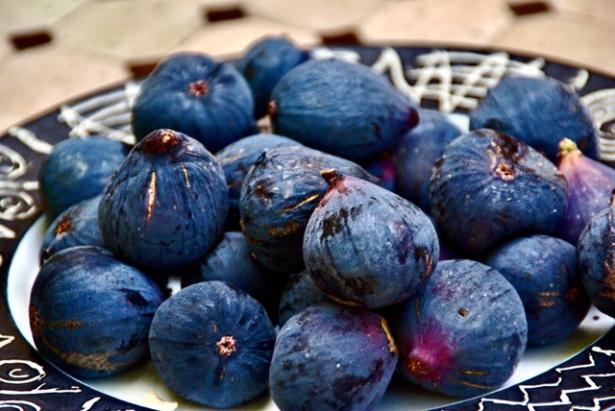From the tip of every branch, like a fat purple fig, a wonderful future beckoned and winked.
— Sylvia Plath, The Bell Jar
I FINALLY CONJURED up the courage to try figs again on Thassos, a northern Greek island where I was teaching poetry for the summer. I was determined to get to the bottom of a fruity mystery from long ago, when a boy had told me the “crunch” of a fig meant I was eating a dead wasp. I’d believed him, and for thirty-plus years I avoided the fruit. But they grow so easily in the sea air and soft pink Mediterranean light. After dinner, it was not uncommon to have fresh yogurt with a dollop of candied figs on top—spoon- sweets, the locals called them. I miss that simple sun-drenched bounty.
Figs are actually inside-out flowers—hundreds of flowers trapped inside a casing. The female fig wasp, still dusted with pollen from her own birth fig, enters an unripe fig through what is known as the ostiole, or the round base, stripping off her wings in the process. The wasp is so small, just two millimeters—about the size of the tip of a crayon— and only lives for two days, during which she must safely penetrate the fig and lay her eggs among the tiny flowers, while also pollinating the flowers. She dies shortly after.
Male fig wasps emerge first from their galls—their egg casings—and, in a bit of seizure that I wish was still mysterious in my mind, actually tear a hole in the galls of the female larvae, fertilizing them even as they lay silent and growing. As the last act in their short lives, the males then dig a tunnel back out of the fruit before dying. When the females wake, they shimmy through these tunnels, catching pollen on their shiny new (fertilized) bodies, and then fly away, sometimes fifty kilometers above the canopy, where they search for the perfect unripe fig to lay their own eggs, continuing the cycle.
Figs are actually inside-out flowers— hundreds of flowers trapped inside a casing.
For more than nine thousand years, figs have been a keystone species, a critical component of the food web. Twelve hundred different kinds of animals depend on them, including a tenth of the world’s birds, and, yes, the wasps who take their name from them. It’s easy to imagine the rank appeal of taunting someone for gobbling up insect detritus. But if it seems like the boy who tried to gross me out all those years ago was right, you might be glad to know that the fruit’s enzymes dissolve any remnants of wasps inside the fig. All that’s left is the juice that Pliny the Elder called “the best food that can be taken by those who are brought low by long sickness.”
I like to think of that first moment of crossing, when the female squeezes into the ostiole, shedding her wings. The wings, almost invisible, are left to scatter at the foot of the tree or nestle inside among the fig flowers. I like to think that they’re still able to flutter and fly and frolic in the form of a parrot or cuckoo or sweets-loving oriole. I don’t worry the crunch; I celebrate the flight.


Spread the word